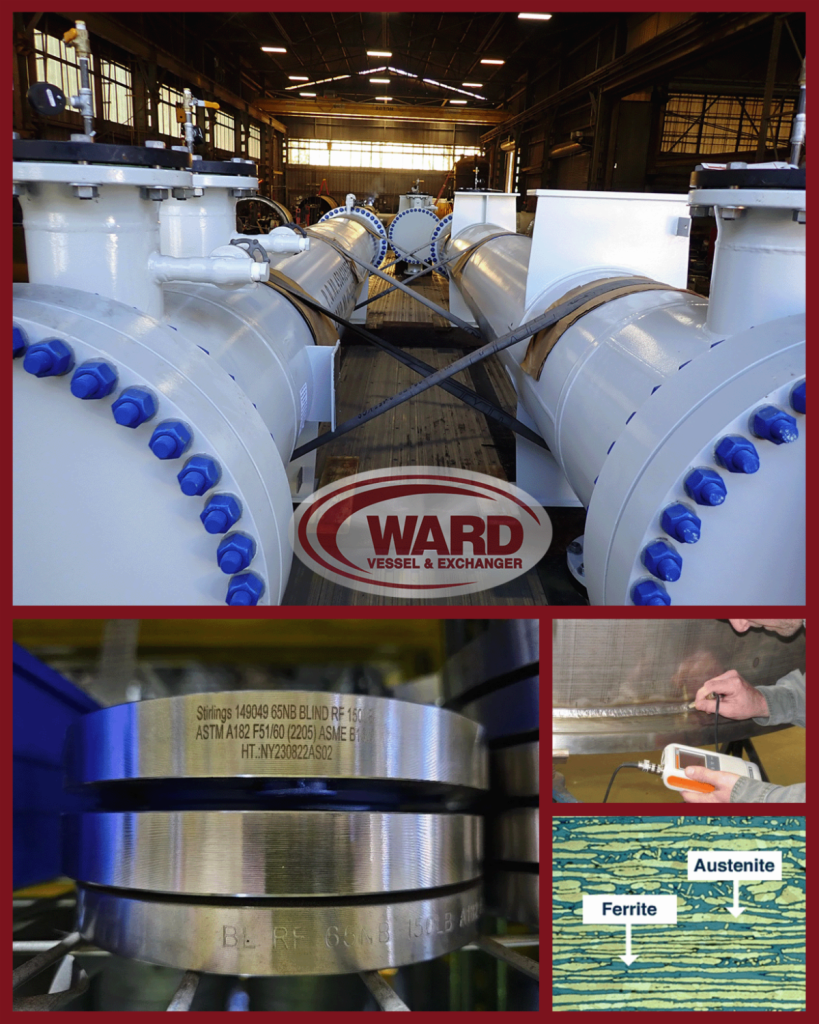Know Your Metal (Pt. 4): Duplex Stainless – Strong but Stubborn
Previously in the Series…
Over the last few months, we’ve worked our way through carbon steel, stainless steel, and high-nickel alloys—each with their own set of advantages and landmines. This month, we turn our attention to duplex stainless steels—materials that offer the best of both worlds in terms of strength and corrosion resistance… and demand the best from your welders and procedures to get it right.
What Makes Duplex Stainless Different
Duplex stainless steels are a family of alloys characterized by a dual-phase microstructure: approximately 50% austenite and 50% ferrite. This balanced structure gives duplex alloys higher strength than standard austenitic stainless steels (like 304/316) and improved resistance to stress corrosion cracking and pitting—especially in chloride-rich environments.
Common grades include:
- 2205 (UNS S32205/S31803) – the most widely used Duplex variety
- 2507 (UNS S32750) – Super Duplex with even higher strength and corrosion resistance
- 2101 and 2304 – “Lean” duplex grades used in lighter-duty applications
The Benefits
- High strength-to-weight ratio: Roughly twice the yield strength of 316L stainless steel, which can reduce wall thickness and total material cost in pressure-rated components.
- Excellent corrosion resistance: Particularly resistant to pitting and crevice corrosion in chloride environments, making them ideal for pulp and paper, offshore, and chemical industries.
- Good weldability: In theory, duplexes can be welded with many of the same processes used for austenitic stainless. In practice, however…
The Challenges
- Ferrite balance must be preserved: The 50/50 phase ratio is not just a material feature—it’s a performance requirement. Improper welding can tilt the balance too far toward ferrite (brittle) or austenite (weaker), both of which can reduce corrosion resistance and impact strength.
- Heat input must be tightly controlled: Too much heat results in grain coarsening and excessive ferrite. Too little heat can result in lack of fusion and increased austenite formation. Either way, the mechanical properties suffer.
- Intermetallic phases: Holding temperatures in the danger zone (approx. 600–1000 °F) for too long can promote the formation of harmful intermetallic compounds (like sigma phase) that ruin toughness and corrosion resistance.
- Post-weld testing often required: Due to the narrow welding window, ferrite testing (using a portable feritscope or lab prep) is often needed to verify weld integrity.
Ward Wisdom: Real Lessons from the Field
- The “Looks Good” That Wasn’t – A duplex pipe spool passed visual inspection and even a quick UT scan—but when tested in service, it showed early signs of chloride pitting. Lab testing revealed excessive austenite in the weld root caused by high travel speed and low heat input. Visuals don’t tell the whole story with duplex.
- The Nozzle Repair That Got Too Hot – A 2507 super-duplex vessel repair required welding in a tight, enclosed area. Without proper interpass monitoring, the weld area exceeded the 300 °F limit and developed intermetallics. Final hardness testing showed unacceptable values, and the entire section had to be cut and replaced.
- The Ferrite “Fail” That Wasn’t – During fabrication of a 2205 piping system, an inspector flagged a ferrite reading of 35% as a failure. However, the WPS allowed for a 30–70% range, and the welds were acceptable. This was a reminder that testing must be paired with code knowledge—not just device readings.
Best Practices
- Use qualified WPSs and know your alloy grade: Don’t rely on procedures for 316 or carbon steel. Duplex needs its own procedures—built and tested for ferrite balance.
- Monitor heat input and interpass temperatures carefully: Keep interpass under control (typically <300°F for duplex, <250°F for super-duplex). Use calibrated infrared thermometers or contact thermocouples.
- Use proper filler metal: ER2209 for 2205 duplex, ER2594 for 2507, etc. Avoid fillers that will skew the ferrite balance unless supported by procedure testing.
- Consider ferrite testing during or after welding: Especially on pressure parts or when corrosion performance is critical.
- Minimize weld area residence time in the sigma-prone range (600–1000 °F): Use smaller beads, faster travel speeds, and staggered passes.
Looking Ahead…
In Part 5: Titanium – Light, Tough, and Technically Demanding, we’ll shift our focus to one of the most demanding metals to weld.







